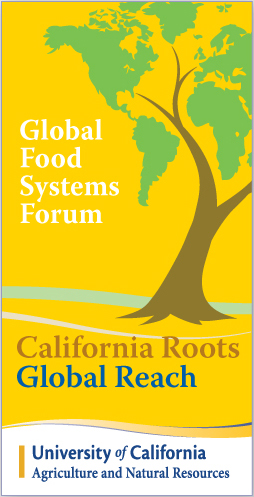All Issues
Public investment in UC fosters answers for global food system
Publication Information
California Agriculture 67(2):82-82. https://doi.org/10.3733/ca.v067n02p82
Published online April 01, 2013
PDF | Citation | Permissions
Full text
In the 67 years that California Agriculture journal has published landmark research by UC scientists, more than 6,000 articles have reported UC Agriculture and Natural Resources (ANR) research and extension to a diverse audience of academics, policy-makers and engaged members of the public. The journal has also provided evidence of a remarkable cooperative investment to bring science-based solutions to everyday problems.
The year 2014 marks the centennial of the Smith-Lever Act forming Cooperative Extension. Together with the Morrill Act (1862) that launched public colleges and universities, and the Hatch Act (1887) that funded agricultural experiment stations at those institutions, the Smith-Lever Act played a crucial role in forming the land-grant system that today provides accessible public higher education, produces research in the public interest, and extends that knowledge for the public good. The return on those investments has been remarkable.
Today, ANR works with partners in virtually every sector, disseminating research and education that directly benefits citizens, communities, businesses and the environment of the state. As a result of those partnerships, California has been and continues to be the nation's top agricultural state. By every measure, California's command of this top ranking is growing larger, with every $1 invested in agricultural research resulting in $21 in economic benefit to every Californian.
In 2011, California farm revenue topped $43 billion, directly providing 800,000 jobs on more than 80,000 farms. Of more than 400 crops produced in the state, 11 exceeded $1 billion in revenue. Our agricultural exports returned $14.7 billion to the state's economy, and these statistics continue to climb. In one year alone, from 2010 to 2011, agricultural revenues were up 15%.
Driven by the innovation and entrepreneurship of California growers and processors, UC research has been adapted to increase productivity in all major crops, benefitting the whole food system. Over the past 30 years, average yields of almonds are up 122%, processing tomato yields are up 69%, and per-cow milk production is up 44%. UC-developed plant varieties account for 90% of the wheat grown in the state, 65% of California's strawberries, and 40% of world strawberry production. Looking forward, UC academics are advancing research to foster solutions to global climate change, hunger and obesity, invasive pests, endangered natural resources, and water quality and quantity concerns.
Additional information on the scope and impact of UC research and the economic power of California agriculture can be found in new UC ANR publications available on the web at http://ucanr.edu/files/141870.pdf and http://ucanr.edu/sites/Toolkit/files/162595.pdf .
In 2025, providing 8 billion people with quality, affordable and accessible food will be the defining economic, sociopolitical and ethical issue of our time. It is a global challenge. But as the number-one agricultural state in the United States, and one of the world's top food producers, it is also a challenge to California.
On April 9, 2013, ANR will host the Global Food Systems Forum. Producers, geopoliticists, ethicists, economists, humanists and others will address the challenges of protecting our natural resource base (water, soil, air, plants and animals) upon which our food supply depends, the risks we face if we do not, and potential solutions for California and the world.
Keynote speakers include Mrs. Mary Robinson, former president of Ireland and president of the Mary Robinson Foundation — Climate Justice, and Wes Jackson, founder and president of the Land Institute. In addition, two distinguished panels will focus on the geopolitical, ethical, economic and technical challenges facing food systems from a global and California perspective. We invite you to view these discussions via webcast.
To register for the Global Food Systems Forum webcast, please go to our website, http://food2025.ucanr.edu/ . Additional information on speakers, panelists and moderators, as well as links to social media blogs and tweets can be found at http://food2025.ucanr.edu/Blog/ .
I hope you will join us for the webcast and contribute to an ongoing conversation on how best to secure an abundant, affordable, and secure food supply while protecting the natural resource base for California and the world.






